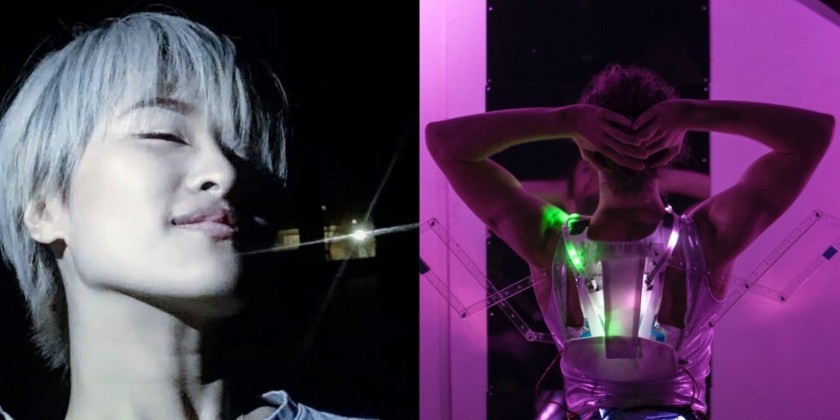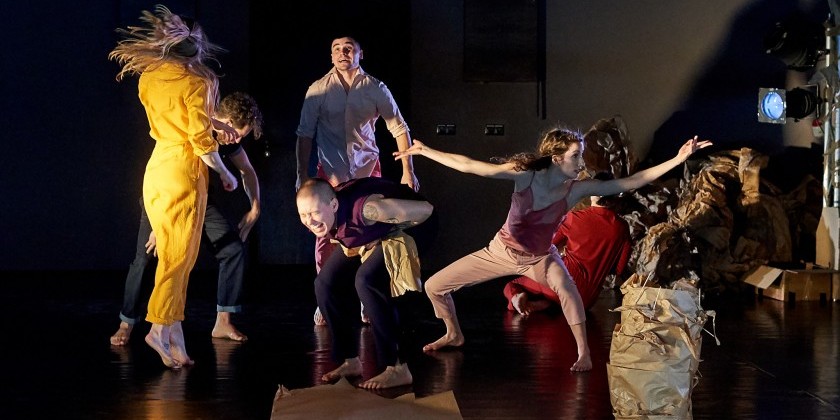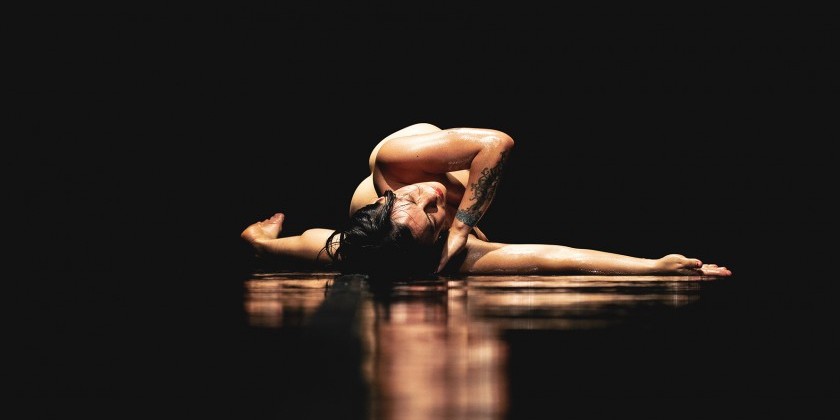IMPRESSIONS: Danielle Russo Performance Project’s “Sentinel” at Brooklyn Historical Society

Brooklyn Historical Society
September 14, 2018
Choreography: Danielle Russo / Producer: Jenny Tibbels
Technical Director: Joanna DeFelice / Makeup Design: Marc Witmer
Costume Design: Jenny Lai / Film and Photography: Luke Ohlson
Performers: Kayla Farrish, Molly Griffin, Jason Collins, Roya Carreras, César Brodermann
In 2017, Danielle Russo, director of Danielle Russo Performance Projects, commenced an enormous task: Create a dance that honors the lived experiences of marginalized people, calls attention to acts of violence and oppression, integrates technology and design, and responds to the U.S. political climate. The culminating work is titled Sentinel, after someone who watches and bears witness. It shines like a spotlight through a prism, using the personal narratives of five dancers to direct attention toward the scattered fractures within U.S. society.

Russo started Sentinel shortly after the election, and in her program notes, she calls it a direct response to Trump's presidency. She and her dancers rehearsed one-on-one to create site-specific solos structured around incidents of violence in New York's five boroughs. Most importantly, to both Russo and the authenticity of the project, each dancer's identity resonates with their performance site. César Brodermann, a Mexican immigrant, performed in Port Richmond, Staten Island, a neighborhood impacted by ICE raids. Kayla Farrish, an African-American woman, danced at an intersection on Eastern Parkway in Brooklyn where, on September 7, 2017, a noose was found hanging from a tree. Molly Griffin and Jason Collins, both queer white people, performed in and around the MTA. Molly's solo traced the Q train route along which a young queer woman was nearly beaten to death on May 20, 2017. Jason's solo occurred on a C train subway platform. In 2017, commuters along the A/C lines reported numerous anti-gay hate crimes. Carreras, who grew up in a Muslim home, danced at JFK's Terminal 4. Trump's so-called “Muslim Ban” stranded travelers at the airport and barred others from entering the United States.
Russo didn't prioritize publicity for Sentinel's site-specific events, preferring that passersby encounter the work organically. Costumed in skirts constructed by designer Jenny Lai and caked head-to-toe in magenta clay makeup designed by Mark Witmer, the dancers glow like alien beacons on a gray New York City street. As captured by filmmaker Luke Ohlson, their performances are raw and vulnerable, the emotion on their faces apparent.
The show at the Brooklyn Historical Society served as an encore and a separate event. Audience members reference an extensive paper program mapping the site-specific performances and Russo's creative process, as well as the link for a SoundCloud station to access the performers' testimonies.

The dancers perform in a clear, three-sided box, illuminated by harsh white lighting. Instead of the shared skirt, they wear only briefs and the same magenta clay. Griffin, Farrish, Collins, and Carreras perform one-by-one as clips from Ohlson's videos flicker on the wall behind them. Brodermann is not present, so his video plays in its entirety.
Russo worked intimately with the dancers to create their solos, and it's easy to imagine the roller coaster of vulnerability as quiet studio time gave way to a public event. The solos look lived-in, but here, the vulnerability doesn't shine through. Except for Griffin, the dancers rarely focus beyond the see-through walls. Their movement is slow and measured, and it's hard to tell if Russo directed the dancers to bring that quality to the live performance, or if Ohlson's camera created dynamism in the filmed performances when it's actually lacking. The sense of emotional distance traveled during the live performance feels weaker than on film.

That said, Russo's success comes from the way she plays with visibility in the overall design. The stage fills the center of the room, and its starkness intimidates people from walking too close, complicating a program note that invites the audience to circulate freely. When it's impossible to cross behind seated viewers, people scurry from one side of the room to another, eager to skirt the ultra-exposed stage. The clear walls of the box display the dancers as contained, if not caged, and standing too close feels like gawking at a specimen under surgical lights. The magenta clay creates an uncanny effect, erasing much of the performers’ facial expression while highlighting the contours of their body. Dark eyes become bottomless, while light ones pop in high contrast. One can't not look at them, yet the audience hangs back.
Sentinel makes a powerful political statement by amplifying the voices of vulnerable people, but sometimes amplification and visibility are death sentences. The site-specific version directly confronts that tension with its very nature — outdoors and unmediated by a clear performer-audience relationship, the dancers are simultaneously exposed and untouchable. At the Brooklyn Historical Society, Russo devised a space for the audience to contemplate what it means to be a witness to the truth of pain, fear, and confusion. It was apparent that the courage to speak out must be supported by others with the courage to stand up — and stand in solidarity. As a society, we may not be quite ready to confront such testimony.
The Dance Enthusiast Shares IMPRESSIONS/ our brand of review and Creates Conversation.
For more IMPRESSIONS, click here.
Share your #AudienceReview of performances for a chance to win a prize.













